[This profile contains discussion of rape culture and sexual assault.]
Of the main characters I’ll be profiling, Jenny Humphrey has the briefest arc on Gossip Girl: seasons one through three, followed by a few season four appearances and the series finale. Even in that shorter span of time, Jenny is the character whose style evolves the most, whose wardrobe is most influenced by her actor, Taylor Momsen (followed, perhaps, by Serena van der Woodsen/Blake Lively; we’ll get into her in a future issue).
By season four, Momsen’s music career (as lead singer of the rock band The Pretty Reckless) was taking off, and her appearances on Gossip Girl were dwindling. Unlike her “fellow kids” on the show, all in their early twenties by the series premiere, Taylor Momsen was a genuine teenager, only fourteen when the show launched in 2007. As her style developed from teen actress to rock-and-roll frontwoman, so did the fashion choices of her character, though for different reasons.
Eric Daman, the show’s costume designer, cites his initial inspiration for Jenny Humphrey as Molly Ringwald in Pretty in Pink. Like Molly’s Andie, Jenny is a teen girl from the “wrong side of the tracks” (“Gossip Girl Couture”), handy with a sewing machine, DIY-ing before Pinterest made it trendy. But unlike Andie, Jenny never gets her rich boyfriend, Blane (try as she might, over multiple seasons, to land the equally floppy-haired Nate Archibald). Instead, she gets the fun-house-mirror ending: having (questionably consensual) sex for the first time with Chuck Bass, aka Steff.
Like many teen soaps of its era, Gossip Girl perpetuates both rape culture (to put it simply, a culture in which rape is normalized) and the social construct of virginity—especially Jenny’s. Blair Waldorf’s and Dan Humphrey’s are written off during the first half of season one, but Jenny’s remains, a rhinestone around her neck, until the season three finale. We’ll dive even further into the show’s fashion messaging on sex with other profiles, but for now, we’ll take a look at Jenny’s evolution through the seasons and the ways her “purity,” both of conscience and body, and trauma from her sexual assaults are represented through her clothing.
EDIT 7/2021: Throughout the original profile, I quoted from this post, “Gossip Girl, Jenny Humphrey, and Rape Culture," when discussing Jenny’s sexual assaults. I don’t agree with the author’s aside that frames Nate as Serena’s rapist and don’t believe the show’s text or a nuanced understanding of consent supports this claim. For this reason, I no longer recommend the post and I’ve edited my profile to remove these quotes.
I think it’s also important to note that Gossip Girl premiered ten years before the #MeToo movement became widespread, at a time when purity culture and virginity were a huge part of teen pop culture (remember all the Disney stars wearing promise rings?). I’m not saying this to excuse the show’s storytelling, but rather to highlight how mainstream its representations were, and in many cases, still are.
[In every profile, I will cite Eric Daman’s thoughts where they are relevant, though many of my conclusions will be drawn from my own observations and reading, and may not have been his intention. As with any movie, show, book, etc., authorial intent can provide insight into the work, but it is not the definitive interpretation. I believe that once a work is in the world, it becomes as much the reader’s or viewer’s as the creator’s.]
Season One
At the beginning of the show, many of the mainstays of Jenny’s style are meant to make her look even more innocent and childlike than the rest of the cast: bright or pastel colors (but with “an earth tone kind of underset” (“Couture”) to ground her to her father, Rufus, and brother, Dan) and “lots of gummy bracelets, and candy bracelets, and really cutesy necklaces” (“Couture”). Even the shape of her pieces are youthful: For her Constance Billard uniform, she favors a pinafore, not a skirt; on top, a swing cropped jacket or sweater, instead of a blazer.
Let’s take our first look at Jenny’s uniform (1.1) as an example. Note the pinafore, of course, but also the necktie (tying her—sorry—back to her brother, though his own tie is less carefully knotted) and the short-sleeved blouse, the sleeves and Peter Pan collar sweetly trimmed in blue. Freshman Jenny has agreed to address invitations for the party of the week, Kiss on the Lips, in exchange for her own invite. When she presents her work to junior Blair, the queen of Constance, and her minions, we see her gray tights and white-and-black polka flats, her pink ditsy-floral coat.
Though the overall look is less practiced and expensive than Blair’s and the minions’—their white knee socks and heels, tweed jackets and jeweled headbands—Jenny’s obviously already taking pointers from the girls she idolizes. As Daman notes, Jenny may not have as much money or status as her Constance classmates, but she is adept at pulling pieces from vintage and thrift stores that reflect current trends (“Couture”).
After school, Jenny tries on party dresses at Henri Bendel, calling in Dan for a fashion “emergency.” The dress shown, its orangey-pink shade in Jenny’s usual bright palette, costs “more than [their] rent,” but Jenny thinks she can “sew something like it.” They run into Serena and her own brother, Eric, and Serena says that the dress “would look even better in black.”
Later in the episode, Jenny has taken Serena’s advice and remade the dress in black, finishing it with a dainty rhinestone necklace and bracelet, barrette, vintage-looking clamshell bag, and ballerina-like low heels. Rufus, upon seeing her in the outfit, says, “Oh my god. My daughter’s a woman. . . . You look like your mother.”
His words, if creepy, become oddly prophetic—the dress marking her entry into the world of the more mature Upper East Side, her ties not to her mother, her family, but to other Constance girls, to the pain they share. At the party, Chuck chooses Jenny as his next victim and invites her up to the roof on the pretense of “talking.” After trying to ply her with champagne, he forcibly puts his mouth on hers and pins her arms; Dan and Serena soon interrupt his assault. Earlier in the episode, Chuck similarly assaults Serena, after revealing he saw Serena and Nate having sex—the implication being that if Serena will sleep with her best friend’s boyfriend, she’ll sleep with anyone. It’s sadly fitting, then, that Serena was the one who told Jenny the dress would look better in black—knowing, most likely, that black will be a more sophisticated choice than bright pink for an Upper East Side party; not knowing, of course, the other initiations it will come to symbolize. The color black has many meanings in U.S. culture—elegance and chicness, death and mourning. Most importantly, black is often juxtaposed with white—the color most associated with purity, innocence. (There is, of course, racist reasoning behind this dichotomy.)
Remember the color black, the black dress; they’ll come back again and again—not just with Jenny, but with Blair, too. After all, it is Blair who Jenny asks if Chuck is bragging about her, Blair who tells her, “If you want to be part of this world, Jenny, people will talk. Eventually. And you need to decide if all this is worth it.”
Let’s jump ahead to episode five. Jenny’s uniform has updated slightly: still a pinafore; a Peter Pan collar; a plaid swing jacket with big buttons, in a Humphrey-favored neutral plaid (appropriate, as she’s advising Serena on her date with Dan); but instead of a necktie, the crossover tie that Blair favors. It’s a small change, but one that’s believable for Jenny at this point in the season. I can imagine Rufus being willing to spend money on new uniform components; all for her education!
Blair invites Jenny to her annual sleepover (a substitute for Serena, who’s busy with her date). Jenny arrives prepared for any normal sleepover: her Hello Kitty sleeping bag and floral tote, a pair of bunny slippers tucked in the front pocket. She’s not expecting the trundle beds, racks of clothes, Blair in a silky slip and robe. Jenny wears a gray tank and cropped houndstooth cardigan, a key among the many charms on her neck. It’s a marker of her lower-class status: Blair doesn’t need a key to her home; an elevator opens into the foyer.
Blair runs Jenny through a series of outfits, until they settle on a yellow strapless dress, a black-and-gold coat added outside—an appropriate choice for Serena’s stand-in, as yellow and gold are usually her colors. “I don’t really feel right,” Jenny tells Blair, and the little gold question mark around her neck confirms her emotional state; she’s uncomfortable in this new world of sex and drinking. As the night wears on and more gin martinis are downed, and Jenny engages in a series of escalating dares with Blair, she gains more confidence, ending the episode by successfully stealing a sequined jacket from Eleanor Waldorf Designs, Blair’s mother’s store.
Again, this isn’t a normal Jenny piece: the sequins more Serena, the bold blues more Blair, but its high neck covers any initial question of what she was willing to do to enter this world. She’s in, and she believes that it’s “worth it.”
In episode six, we see the same yellow color story for Jenny, but this time she is harnessing her newfound power, attending a masquerade ball in secret. Her mask is still very Jenny—silver jeweled with a spray of pastel purple feathers—but her yellow confection of a ball gown and printed fan (all supposedly borrowed from the costume department at BAM) are enough to disguise her to Chuck. She plays hide-and-seek with him, but this time, he’s left locked on a rooftop, without his clothes, phone, or dignity. Jenny is delighted by the outcome—“[the night] was everything I hoped”—and the viewer is left to think that she’s now “over” her assault.
In the party’s bathroom, she trades accessories with Serena, who is also wearing a yellow dress. In her new mask and fur stole, Jenny is quickly mistaken for Serena by Nate. Though he’s supposed to be finding Blair before midnight, Nate instead confesses his feelings for Serena, telling Jenny he’s going to kiss her if she doesn’t stop him; when he does a few seconds later, Jenny runs away. Now, Nate is never the most perceptive character in a room, but even Blair, even Jenny’s own brother, Dan, confuse the fleeing Jenny with Serena. With the luxuries of wealth—the filigree of the mask, the fur of the stole—come the weight of more secrets, more trauma. The colors, too—black and gold—echo the previous two times Jenny has imitated Serena. Jenny leaves behind only a rhinestone bracelet, but it’s enough for Blair to realize that she’d snuck into the party.
At Blair’s insistence, Jenny reveals Nate’s confession (1.7) and is dismissed as a minion “for good” by her humiliated queen. While their outfits may initially seem complementary—sharing the same palette, the same pattern, they’re actually dissonant. Blair wears a preppy cream cardigan, green plaid shirt, and blue skirt with small white polka dots; Jenny’s swing jacket, paired with a plain purple shirt and jeans, is the inverse of Blair’s skirt: large lavender dots on a cream background. The effect is much sweeter, more childish, and ultimately, less powerful. Even Jenny’s question mark necklace makes another appearance, signaling the confusion that Nate’s secret has reintroduced into Jenny’s life.
Still, Jenny’s job assisting at the upcoming cotillion only reinvigorates her interest in the Upper East Side, and after she helps repair Blair’s cotillion dress, she’s back as a minion, if a continually hazed one. But the answer to her woes soon comes: she overhears Serena telling Dan that Blair has slept with both Nate and Chuck, and once Gossip Girl spreads the rumor, Jenny confirms it to Nate (1.13).
The other minions soon dethrone Blair, and Jenny follows them up the Met steps, leaving Blair behind. No headband, like the older girls, only a pink studded beret. Her blue coat, a repeat from earlier in the episode, has a juvenile hood and toggles; perhaps she got it last year and pulled it out again this winter. But, under her crossover tie, a ruffled blouse collar, much like the high-necked collars Blair favors, peeks out; a glimmer of power.
This outfit serves to make Jenny’s next appearance even starker. She checks off three items that she’s never worn before: a pointed collar, a gold headband, and a long plaid coat, not in a safe Humphrey neutral but a bold Waldorf red. A new minion agrees to return Jenny’s library books, and like Jenny before her, she wears a pink hat. Hers is even more youthful than Jenny’s: a Fair Isle knit, two tassels framing her face. Jenny is no longer the youngest innocent, the go-to gofer, in the group.
With Blair dethroned, Jenny falls in step with the rest of the minions, though she can’t keep up with them for long: While her collars are ruffled and her head is banded, she doesn’t have the money for an endless parade of looks. In episode fourteen, she repeats her mint coat a few times, the collar’s flower appliques a more luxurious, tactile version of the ditsy floral prints she once favored. Ironically, the coat itself is Valentino—the same brand as the red gown Jenny later steals from a minion’s mother’s closet. She trades the stolen gown for a vintage black-and-gold Dolce & Gabbana, telling the shop owner that the dress is “more [her] color.” Strange, as the only times she’s worn black and gold in the series are when she’s imitated Serena.
After the minions discover her thievery, Jenny is able to keep her position in the group by first bringing Nate as a date for one of the minions, and then by finding her own rich boyfriend, Asher.
Bubble Episode
This brings us to this profile’s bubble episode: an examination of each outfit worn by the character in one particular episode. For Jenny, I chose episode sixteen, “All About My Brother.” Selfishly, perhaps, because it features some of my favorite Jenny ensembles, but also because it’s one of three (three!) episodes that center on Jenny’s virginity.
In the first scene, Jenny, Blair, and their respective minions meet for breakfast on the Met steps. It’s easy to tell each minion’s allegiance: Jenny’s girls are pastel, while Blair’s are bold. Jenny is working her new staples—a pointed collar, a headband—while her buttery trench evokes her earlier forays into yellow. Jenny is hosting her first Upper East Side party with Asher that evening, and she’s high on the power of having a wealthy, handsome boyfriend.
And yet, her fishnets stockings, paired with silver Mary Janes, are an unexpected touch. While Jenny will don many pairs of fishnets in seasons two and three, she’s never worn them before in season one. Fishnets are often associated with female sexuality and availability, so their appearance hints at the story to come.
The same morning, Dan sees Asher kissing another boy outside school and confronts him. “Are you calling me queer?” Asher replies and then utters two sentences that have haunted my nightmares for twelve years: “You wanna know how queer I am? I’m so queer I’m gonna pop your sister’s cherry tonight.” Instead of gagging, Dan continues the grand tradition of men protecting Jenny’s “honor”; his attempt at a beatdown is quickly stopped and dismissed by Jenny. To try to get Jenny’s attention, Dan sends the story to Gossip Girl.
Later, Jenny asks Asher about the blast, looking infinitely younger: her yellow power trench, in various states of undone since breakfast, is gone, revealing her pinafore underneath. Even her blouse looks more childish: now we can see it’s pale pink and white pinstriped, with little bows on the short sleeves. She tries to initiate sex with Asher, but he rebuffs her, explaining what he thought was implied: Jenny is his beard, his social status and resources in exchange for her cover. He asks her if they can “put the rumors to rest,” and a few hours later, a Gossip Girl post claims that Jenny lost her virginity to Asher.
Dan, keeping in character, yells at Jenny about the blast, and she confirms it isn’t true. In the privacy of their loft, she wears a striped cardigan, a little fabric boutonniere at the bust. Like the fishnets, the flowers reflect the story—a physical manifestation of her supposed “deflowering.” Much like the little appliques on her mint coat, these flowers are tangible, touchable: the stuff of real consequence. Jenny leaves for the party against her father’s will: “I’m not a little girl anymore. You can’t make me do anything.”
The flower motif continues through the party itself: Jenny’s lilac dress is covered with little blossoms; her matching headband, too. Eric arrives and reveals, in front of all the guests, that he was the boy kissing Asher that morning; Jenny tries to cover for her boyfriend, but Blair proves Eric’s story by sending Asher’s texts to Gossip Girl. With that, the minions leave Jenny behind for their true queen, Blair—herself wearing a black dress. She carries all the sophistication and power Jenny has strived for since the pilot, and yet with it, a heaviness, the pearls pulled tight around her neck, bound around her wrists.
Much like the night of the sleepover, Jenny returns to the Waldorf penthouse, but this time to tell Blair she’s done with their games: “You asked me before if it was all worth it. My answer is it’s not.” Over her party dress, she’s thrown a hooded coat in various checks of brown, blue, and black, almost like a deconstructed Humphrey plaid. She’s going back to Brooklyn and her family, done (for this season, anyway) with the Upper East Side.
After Jenny returns home, the season is pretty much a wrap for her. The finale ends with the promise of a summer Parsons internship with Eleanor Waldorf, Blair’s mother.
[Look out for part two, which will cover season two onward, coming this evening.]



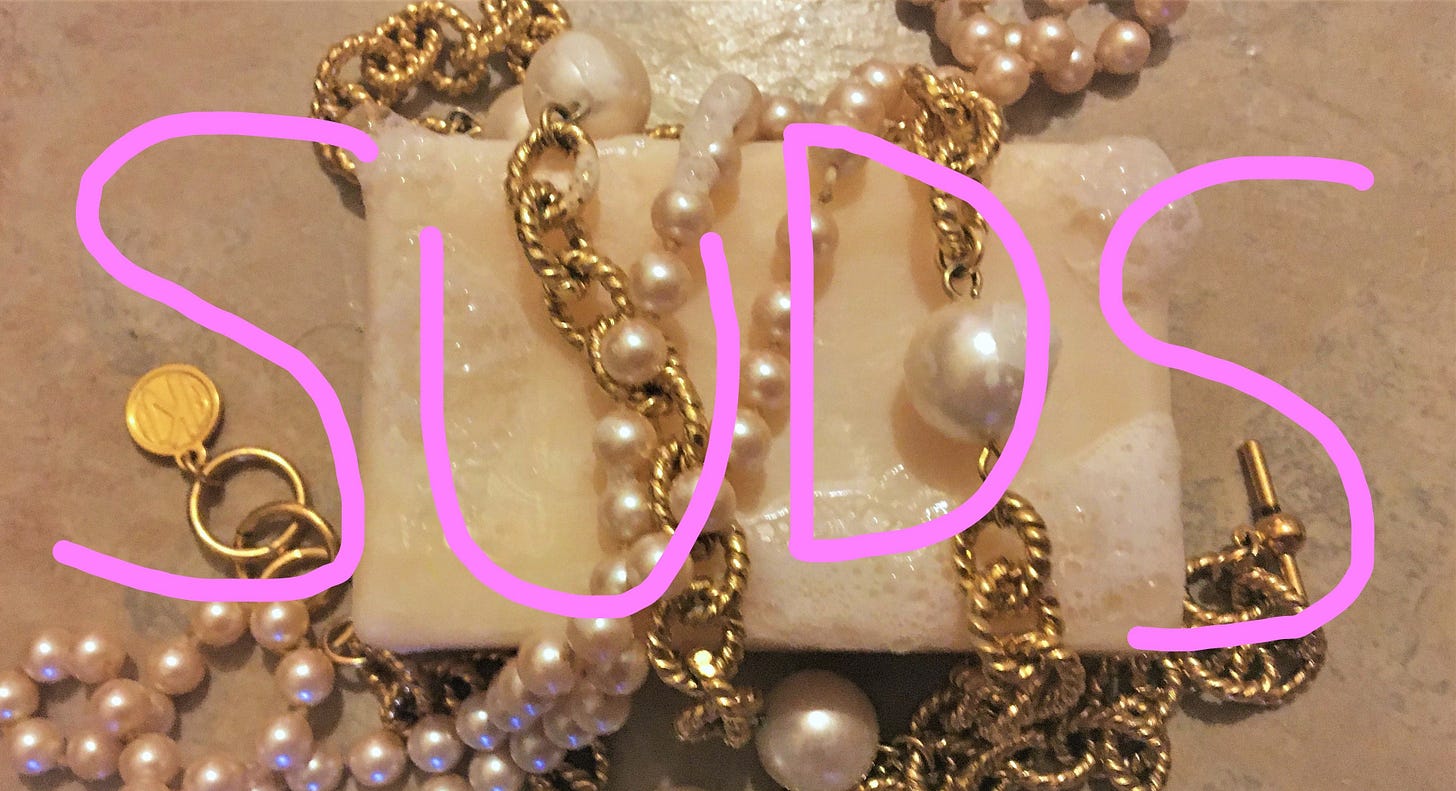
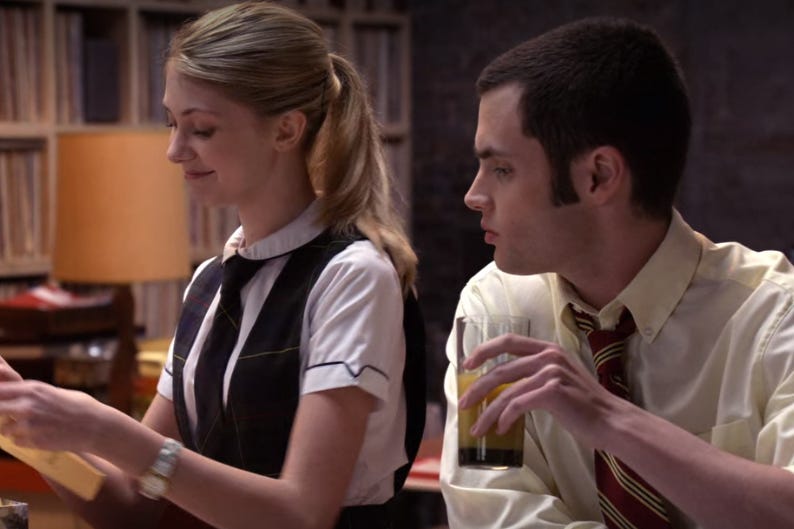







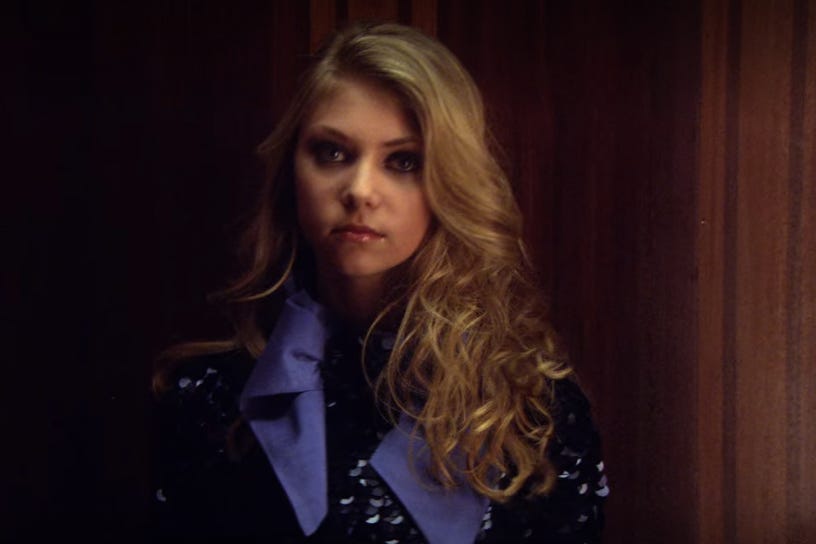








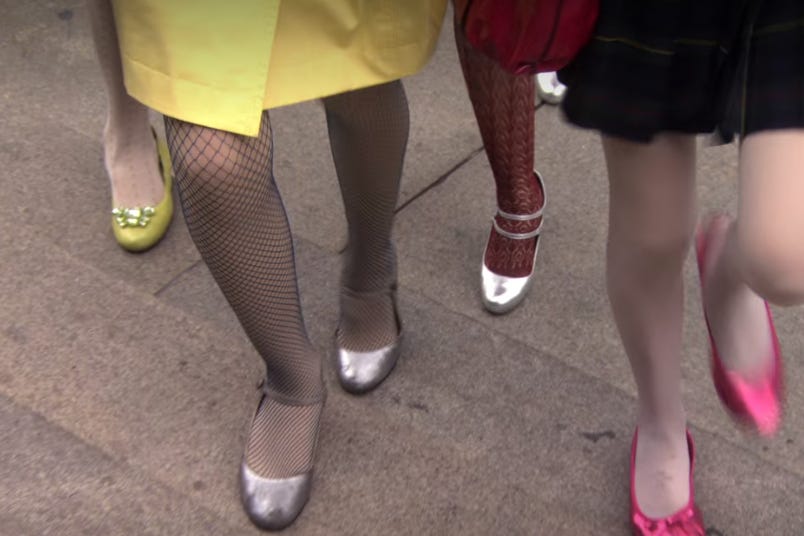
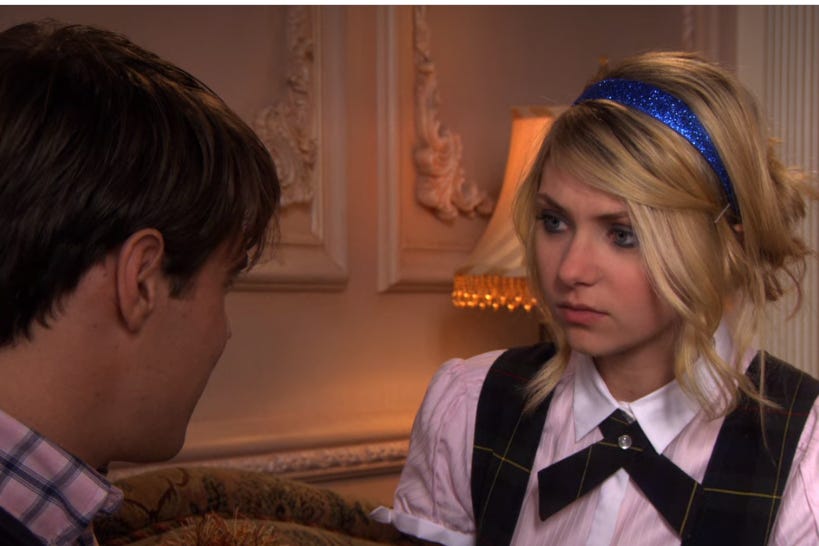




So, I read the Jenny posts in reverse order. I am really glad, once again, that I stumbled on your page. I find this so insightful. Jenny's style is a really great way to tell her story.